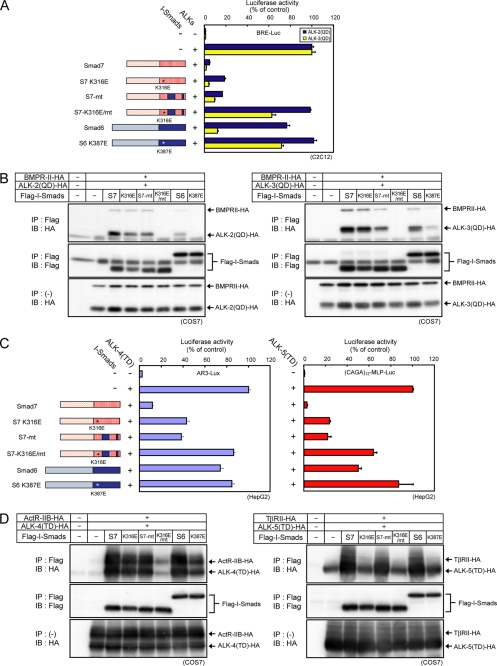FIGURE 5.
Smad7 utilizes two distinct regions for inhibition of TGF-β family type I receptors. The regions in Smad7 responsible for efficient inhibition of ALK-2 signaling (residues 331–361 and 379–387) were replaced by the corresponding regions of Smad6 (S7-mt), and a lysine in the basic groove (Lys-316 for Smad7 and S7-mt, or Lys-387 for Smad6) was converted to glutamic acid (schematically shown at left). A, inhibitory effects of I-Smad mutants on ALK-2 and ALK-3 signaling were determined by luciferase reporter assay using BRE-Luc in C2C12 cells. Expression of each construct was confirmed by immunoblotting. B, physical interaction of I-Smads with ALK-2 and ALK-3 is shown. COS7 cells were transfected with the indicated plasmids. I-Smads were immunoprecipitated (IP), and co-precipitated each type I receptor was visualized by immunoblotting (IB; top panel). Precipitated I-Smads (middle panel) and expression of type I receptors (bottom panel) are also shown. C, inhibitory effects of mutant I-Smads on ALK-4 and ALK-5 signaling were determined by luciferase reporter assay using AR3-Lux or (CAGA)12-MLP-Luc respectively, in HepG2 cells. Expression of each construct was confirmed by immunoblotting. Results are given as percentages of control. Error bars represent S.D. D, physical interaction of I-Smads with ALK-4 and ALK-5 is shown. COS7 cells were transfected with the indicated plasmids. I-Smads were immunoprecipitated, and co-precipitated each type I receptor was visualized by immunoblotting (top panel). Precipitated I-Smads (middle panel) and expression of type I receptors (bottom panel) are also shown.

